From the Field
August 28:
Paul Holt from his just-concluded tour, China: Lhasa and the Tibetan Plateau
This year's tour was superbly memorable encountering a wide variety of awesome birds and mammals amidst truly spectacular 'Roof of the World' surroundings. We saw almost all of our target species with highlights including a cooperative, but typically brief, Chinese Grouse; a spectacular performance from several Przevalski's Partridges; superb looks at both Tibetan Eared and up to 16 Blue Eared Pheasants; majestic Black-necked Cranes on no less than four days; four Amur and up to 13 Saker Falcons in a single day; a prolonged encounter with a family of Henderson's Ground Jays; Ground Tits galore; great looks both Mongolian and Tibetan Larks; White-browed Tit-warbler and more Phylloscopus warblers such as Gansu, Smoky Tickell's and Alpine Leaf than you could shake a stick at; Guldenstadt's Redstart; a complete haul of the region's snowfinches; Mongolian Finch, six species of rosefinch including Pink-rumped and Tibetan and all of Tibet's endemics with Brown-cheeked Laughingthrush and Giant Babax both putting in superb appearances.
For the umpteenth year we again saw the full set of Przevalski's Plateau birds - his partridge, nuthatch, redstart (arguably the prettiest member of the genus) and no less than seven of his finches - the latter a taxonomic enigma that was once a rosefinch then a bunting and now has its own family!
We also reveled in some superb mammal encounters including five Tibetan and three Red Foxes, two Wolves, four wild Yaks, over 100 Kiang (also known by the less flattering name Tibetan Wild Ass), 800 Tibetan Gazelle in a single day & last, but certainly not least no less than 65 Tibetan Antelope.
We watched birds against the stunning backdrop of the high altitude lake Qinghai Hu (Koko Nur to many), spent a fabulous day on the train to Lhasa (the highest elevation railway on the planet) and somehow also managed to fit in a full days sightseeing in Lhasa were we ventured in to the mighty Potala Palace!
We have a ground agent that looks after us like no other and enjoyed superb food and good quality accommodation throughout. Its not an exaggeration to say this was a brilliant trip and a great insight into life in Tibet and on the 'Roof of the World'!
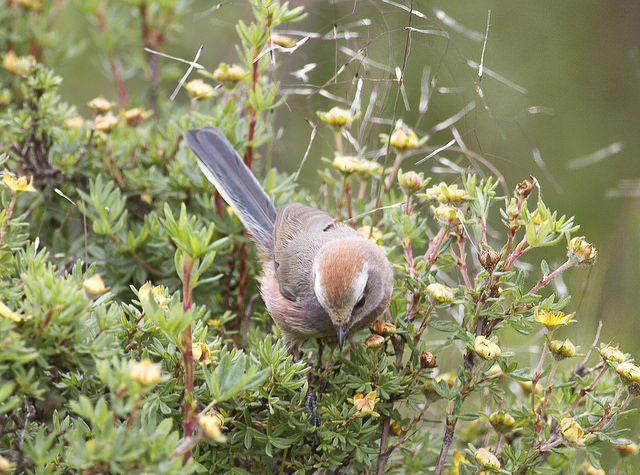
White-browed Tit-warbler
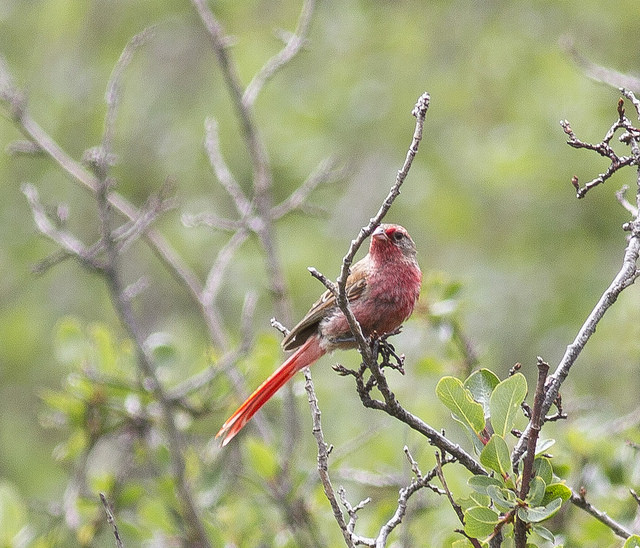
Przevalski's Finch
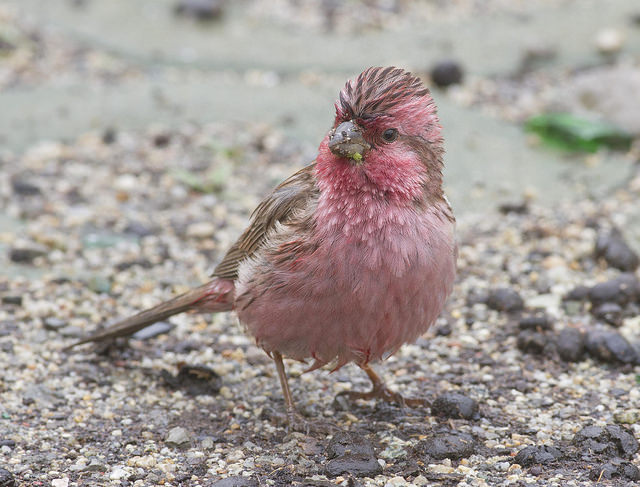
Stresemann's (Pink-rumped) Rosefinch

Potala Palace
August 22:
Rich Hoyer on his just-completed Marvelous Mato Grosso, Brazil tour
On this year’s Marvelous Mato Grosso tour, the Jaguar near the end was a highlight for almost everyone but the Yellow Anaconda and Giant Anteater were close contenders, and they’re even more rarely spotted. But this was indeed a birding tour, and we tallied some 450 species including some really good ones. At Chapada dos Guimarães it was hard to choose between the unexpected male Coal-crested Finch (photo below), a Collared Crescentchest (one of the first birds of the morning), the stately Red-legged Seriemas, iconic Red-and-green Macaws, the shockingly colored Helmeted Manakin, or the drab but seldom seen Pale-bellied Tyrant-Manakin.
Then came our short week at Cristalino, with challenging but extremely rewarding birding. We had a few highlights on the trails, such as a Gould’s Toucanet, Pavonine Quetzal, and a singing (and seen) Musician Wren on the giant Brazil Nut Tree trail (below). Giant Otters and fabulous puddle parties of butterflies on the river (below) were a highlight, as was our time on the canopy towers where a Tooth-billed Wren at eye-level and looking down on a White-necked Puffbird (below) were some of the memorable sightings.
We reached the Pantanal a bit apprehensive with an approaching cold front and with news that water levels have never been higher this late in the dry season. But there was no need to fear. Birds were abundant and easy to see everywhere, such as the Toco Toucan (below) and Crimson-crested Woodpeckers at Pouso Alegre Lodge pictured below. We made many roadside stops for birds and animals, the first being a Giant Anteater (below if distant) in a termite mount-studded pasture on our arrival afternoon. Then on the way south to Porto Jofre an 8-feet-long Yellow Anaconda (below) was spotted on the shoulder by our driver Robson, and we watched cross the road. Then came the excitement of the boat rides on the Cuiabá River, and in our first afternoon, in the midst of the cool and windy cold front, Giant Otters and Capybaras were the only mammals we spotted. But on the next morning ride we receive radio news of a pair of Jaguars, which we arrived in time to see slink off into the deep grass from our boat. Then 20 minutes later came the prize animal, a female furtively watching a pair of Capybaras on the opposite bank (below). The whole tour was a fabulous experience from beginning to end.

Coal-crested Finch
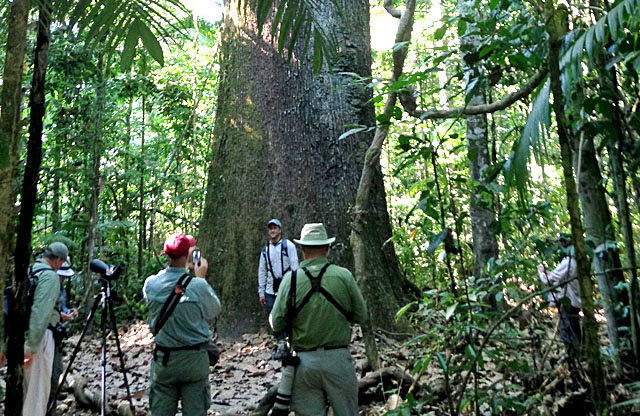
Eight hundred-year-old Brazil Nut Tree
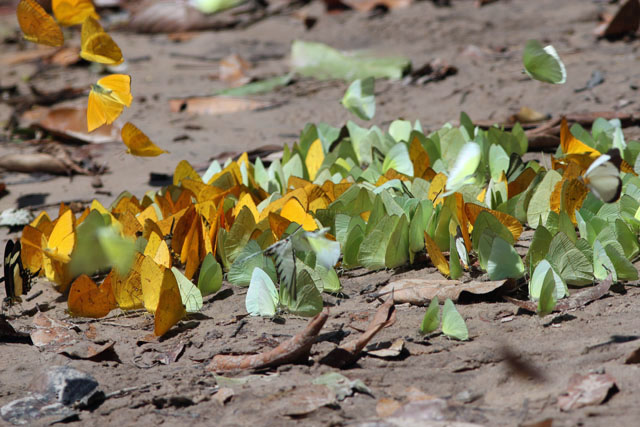
Just one of the amazing "puddle parties."
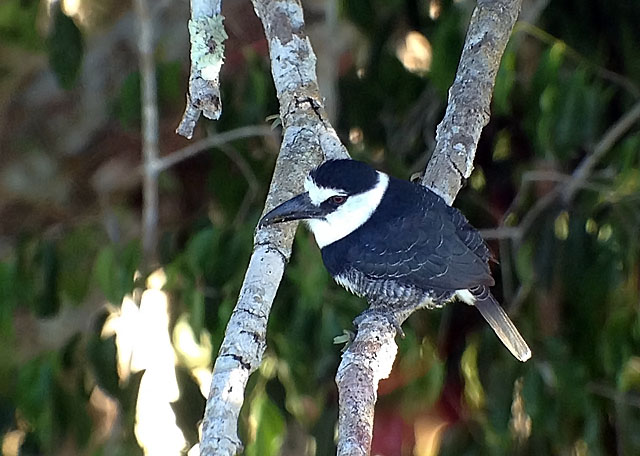
White-necked Puffbird

A brilliant Toco Toucan
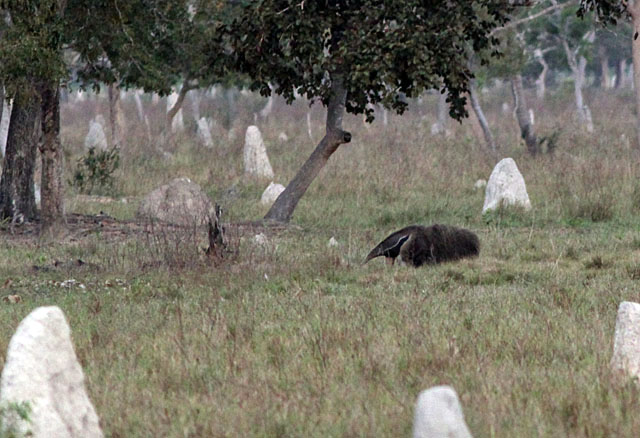
A Giant Anteater at work in tne termite fields

A speed bump...No, a Yellow Anaconda
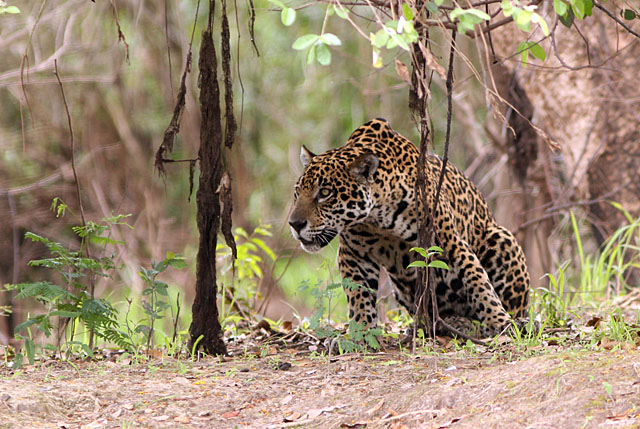
A most riveting Jaguar
August 15:
Jon Dunn from his on-going tour of Southeastern Arizona
We are most of the way through our "second spring" tour and have enjoyed the relative coolness and wet conditions of the monsoon in comparison to the earlier hot June weather. We've had a fine variety of montaine warblers, including this Red-faced, on Mt Lemmon (thanks, Dixie Sommers), and thus far we have recorded 11 species of hummingbirds including three Plain-capped Starthroats and two White-eared Hummingbirds, along with a nice adult male Lucifer (post-script: we ended up with 14 species!). The Five-striped Sparrows were singing and active in California Gulch and Black-capped Gnatcatchers were recorded at two different locations. In addition to the birds we had stunning views of a Gila Monster and had two very interesting snakes, a Checkered Garter Snake and a Sonoran Mountain Kingsnake. Now on to the Portal and the Chiricahuas and maybe, with luck, a Montezuma Quail.

Red-faced Warbler
Plain-capped Starthroat
August 5:
Rich Hoyer on his just completed tour of Costa Rica
Rain is good for life – the tropical forests and the residents depend on it, and that’s what we came to Costa Rica for. So when I hadn’t seen a drop in my first three days in the country, I was starting to get a bit worried that things would be too dry. I need not have feared – by the end of the tour the news came that it had been the wettest July on the Caribbean slope in 30 years, thanks to a very persistent El Niño-influenced weather pattern, and we got to enjoy more than our share of it. But there were plenty of breaks and gorgeous spells, and through the showers and occasional downpours we persisted and saw some truly fantastic birds and tropical nature.
Starting with the fabled Respendent Quetzal and several fine Talamanca endemics such as a surprisingly cooperative Wrenthrush and a spectacular view of the Fiery-throated Hummingbird’s gorget in the mountains south of San José, we then visited four lodges in great locations on the Caribbean slope.
Snowcaps bathing at Rancho Naturalista were a treat, and a very special experience with a pair of Sunbitterns on the nearby Platanillo River was memorable. The moth sheet here was also a highlight, not only for the moths but for the birds that came in to snack, such as a a pair of Buff-throated Foliage-gleaners and a White-breasted Wood-Wren.
At Tortuguero we tried for Green Sea Turtles on an off-night (in an off-year) when none were spotted, but that was more than made up by the delightful boat rides among the palm-lined canals and lagoons, where Great Green Macaws were a surprise. A night boat ride began with a Smoky Jungle Frog, then a Central American Woolly Opossum, then a Kinkajou, and ended with two Great Potoos. As we left the national park by boat, our group’s star spotter found some Great Curassows right next to the river.
Maquenque Ecolodge’s highlights were the Scarlet Macaws that flew in and preened each other, a gorgeous Green-and-black Poison-dart Frog, and the feeders by the dining area, which we got to enjoy during the six hours of rain and storms that set in during the middle of one day. Our fabulous driver Ricardo was to thank for the cooperative Black-and-white Owl he found perched over the driveway that evening.
At Celeste Mountain Lodge, the persistent wind, fog, and rain made birding difficult at times, but one afternoon turned out very nice, and bird activity picked up on the very well-maintained forest trail, with Tody Motmot being a highlight, as well as a small antswarm with very lovely Spotted and Bicolored Antbirds and nearby the most amazing song of a Nightingale Wren.
In addition to birds was a very good mammal and critter list, with four small snakes, lots of frogs, and many great mammals such as a Brown-throated Three-toed Sloth that Ricardo spotted next to the road.

Sunbittern

A fabulous Zugana Io moth

Green-and-black Poison-dart Frog

Waiting out the rain

Passerini's Tanager...seen while waiting out the rain

Black-and-white Owl
July 30:
Jon Dunn on his late winter tour to Thailand
This year’s tour, including the extension, recorded 467 species. Highlights on the main tour included three species of pheasants, including a female Hume’s, good views of multiple foraging Rufous-throated and Mountain Bamboo Partridges four broadbills, three hornbills, a Coral-billed Ground-Cuckoo, an adult Besera perched for over an hour, a close standing Eurasian Woodcock, Giant Nuthatch, and three Limestone Wren Babblers. We also had a number of uncommon to rare winter visitants including Ultramarine and Mugimaki Flycatcher (males), an adult male Red-flanked Bluetail side-by-side with an adult male Himalayan Bluetail, Golden Bush Robin, White-throated Rock Thrush (male), Chestnut Thrush, and a Fire-tailed Sunbird. We also had an Asian Elephant.
On the extension we managed to see three Spoon-billed Sandpipers and fifty Nordmann’s Greenshanks along with both Malaysian and the re-discovered White-faced Plovers. In all (including the main tour) we recorded 46 species of shorebirds. A Collared Pratincole (with Oriental Pratincoles) and a Bay-backed Shrike, both stakeouts, were firsts for Thailand and Southeast Asia. Scarce gulls included Black-tailed and Great Black-headed (Pallas’s). At Kaeng Krachan National Park and vicinity we had a fine variety of woodpeckers, including Great Slaty, five species of broadbills, Ratchet-tailed Treepie, and Kalij Pheasant, and Bar-backed and Scaly-breasted Partridges along with a single male Blue Pitta. Mammals were numerous and included Dusky and Banded Langurs, Fea’s Muntjac, Binturong, Masked Palm Civet and a briefly seen Yellow-throated Marten.

Eurasian Woodcock

Himalayan Bluetail

Collared Pratincole

Silver-breasted Broadbill

Black-backed Kingfisher

Gray-rumped Treeswift

Bar-backed Partridge

A field lunch
July 22:
Paul Holt from a portion of his recent tour of Sichuan, China
Sichuan, the heart of China's endemic zone, offers some superb birding, great accommodations, spectacular scenery and world renown cuisine. Our current tour's enjoying all of this...and more. The sacred mountain Emei Shan was our first port of call and it produced more birds than we could ever have dreamt of - Grey-hooded Parrotbill, Emei Liocichla and Red-winged Laughingthrush all fell at our first attempt. Moving on we had spectacular views of Lady Amherst's Pheasant before reaching the world famous Wolong National Park. No wild Giant Pandas I'm afraid - but lots of other goodies including four Temminck's Tragopan in a single day, Chinese Monal on two days, several Grandalas, fine performances from Snow Partridges and much much more...

Grey-hooded-Parrotbill

Temminck's Tragopan

Grandala

Golden Bush-Robin
July 14: Fabrice Schmitt on his just-concluded private tour to the wilds of Peru
I'm just come back from a two week private tour in North and Cenral Peru to look for White-masked Antbird and a few more of Peru's local and rare birds. It was a challenging but a very successful trip with not only good views of the White-masked Antbird, but also Scarlet-banded Barbet, Long-whiskered Owlet, Pale-billed and Bay Antpitta, Buff-fronted Owl, Marvelous Spatuletail, Creamy-bellied Antwren, and Cloud-forest Screech-Owl, among many others.
That trip took us to some very remote parts of the country, and we had to use small planes and 4x4 vehicles to reach some of them. The location for the Scarlet-banded Barbet was definitely the most difficult to reach: six hours on an extremely muddy road to travel only 30 miles! Look at the picture below. Have you ever been on a muddy road like this one?? We wouldn’t do it if it wasn’t for a bird!
White-masked Antbird
Scarlet-banded Barbet

Long-whiskered Owlet
Marvelous Spatulatail

Pale-billed Antpitta
July 9:
Steve Howell reports from his ongoing Ecuador: A Week in Paradise tour
Yesterday’s late afternoon cold beer and chips, along with Sunbitterns singing and flight-displaying (wow!), would normally be a grand finale to any day birding, but as can be the case on Ecuador: A Week in Paradise, there was more to come – superb views of a spectacular male Lyre-tailed Nightjar and a Common Potoo. All this after a morning that featured a fierce little Cloud-forest Pygmy-Owl, a stealthy and huge Wattled Guan, Golden-headed Quetzals, and point-blank views of the poorly known, seldom-seen Blue Seedeater (below, andgenetically now a bunting!). Today’s surprise was a pair of White-faced Nunbirds beside the road, perching on power poles and mossy branches – you decide which photo (below) is the more esthetically pleasing... Oh, and I did I mention the 28 species of hummingbirds? And all those gaudy tanagers, plus amazing orchids (below) and other life..., and still more than half of the trip to go!
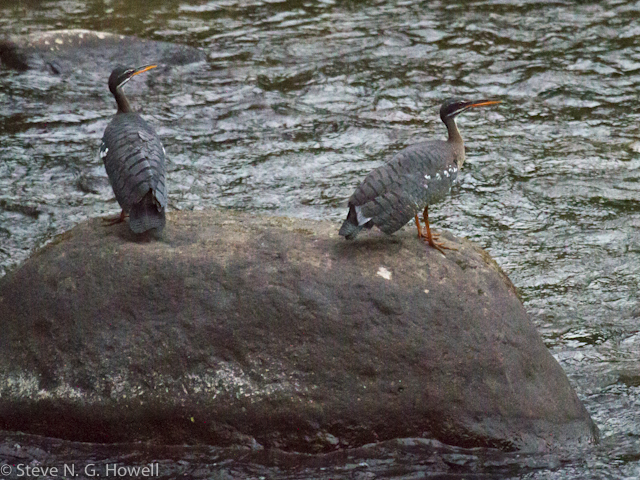
Sunbitterns
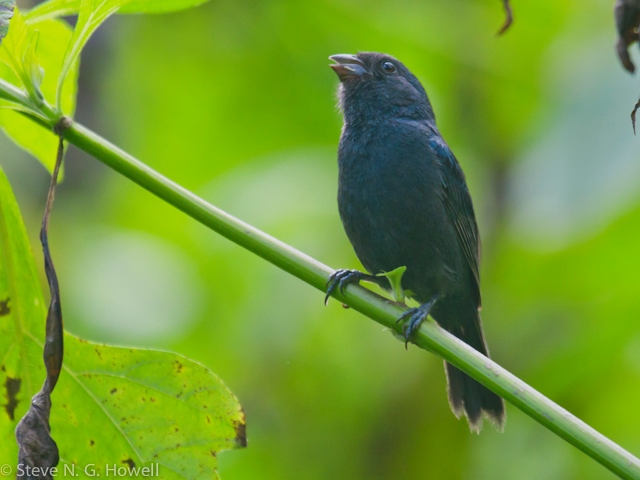
Blue Seedeater
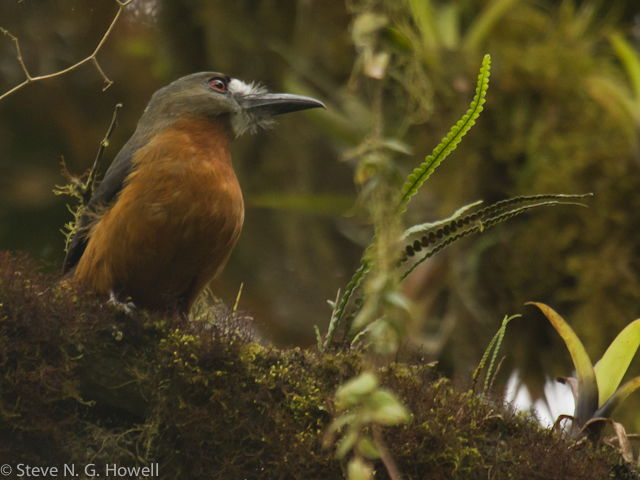
White-faced Nunbird
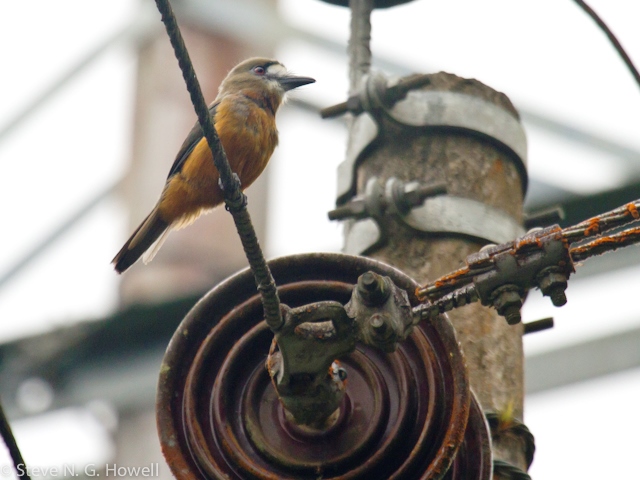
White-faced Nunbird
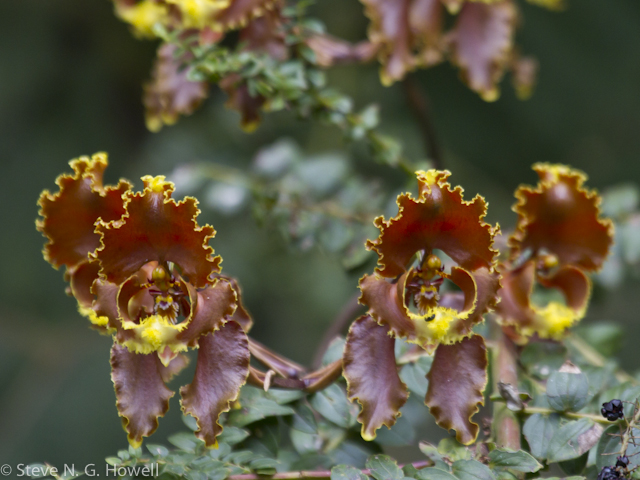
June 25: Gavin Bieber and Steve Howell: A second report from their ongoing tour Alaska: The Majesty of the North
There's more to life than birds - the mammals here are truly amazing. Yesterday in warm sunny conditions we watched a pair of Bristle-thighed Curlews foraging on the tundra against a world-class backdrop of snow-cloaked peaks. After having started the day with a roadside Gray Wolf (!) we ended the solstice under midnight on the sun-drenched rocky tundra by watching Red Knots in song flights with newly hatched chicks! What a day! It's also the breeding season for mammals, including a baby Alaskan Hare that could have fit in the palm of our hand, an innocent baby Spotted Seal sunning itself, and this morning a baby Beluga (dark, unlike the milky white adult). Plus delightful Aleutian Terns, Arctic Warblers singing everywhere, Bluethroat, Red-necked Stint, Arctic Loon, and the other usual suspects. Now on to Seward and finishing up in Barrow...

Bristle-thighed Curlew with a view

Roadside Gray Wolf (Editor comment: Not fair gentlemen, not fair....)

Baby Alaska Hare

Baby Spotted Seal

Mothern and calf Beluga

Aleutian Tern
June 24: James Lidster on his just concluded tour of Mongolia
I have just returned from my 8th tour to Mongolia, and yet again the country never fails to amaze me! There seem to be so few places to visit nowadays where I feel the wilderness and isolation that I do in Mongolia.
We saw some great birds including Oriental Plovers, Pallas's Sandgrouse, Demoiselle and White-naped Cranes, Pallas's Fish Eagles, Amur and Saker Falcons, Swan and Bar-headed geese, Mongolian Ground Jays, Kozlow's Accentors, Wallcreepers, Lammergeier, singing Siberian Rubythroats, Black Woodpecker, Mongolian Lark, White's, Dusky and Red-throated Thrushes, Azure and White-crowned Penduline Tits, Godlewski's and Yellow-breasted Buntings, Long-tailed and Beautiful Rosefinches, we even found the 2nd Rosy Pipit for Mongolia among a whole suite of shorebirds and passerines that would have you running all over Gambell or Attu!
The scenery changes daily and blows me away every year, the ground crew we work with make camping a pleasure (we have now cut the total number of nights camping to just 4) and we even experimented with larger tents, beds and bedding. The latter saved us the need to carry sleeping bags, the beds were an absolute luxury and the tents were set up each time for us and were large enough to stand up in....sadly the Mongolian weather being what it is, meant they didn't stand up to the strong winds we had one day. And if there is one thing the ground crew are prepared for, it is the unexpected, so out came the reserve tents!
The food prepared by our chef from her tent is better than I could make in a kitchen, and can there be anything more delightful ending the day with a glass of red wine or a Golden Gobi beer reflecting on another great day's birding while looking over a vast Mongolian plain?

Oriental Plover

Demoiselle Crane

Bar-headed Geese

Mongolian Lark

Home away from home 1

Home away from home 2

Daurian Shrike





